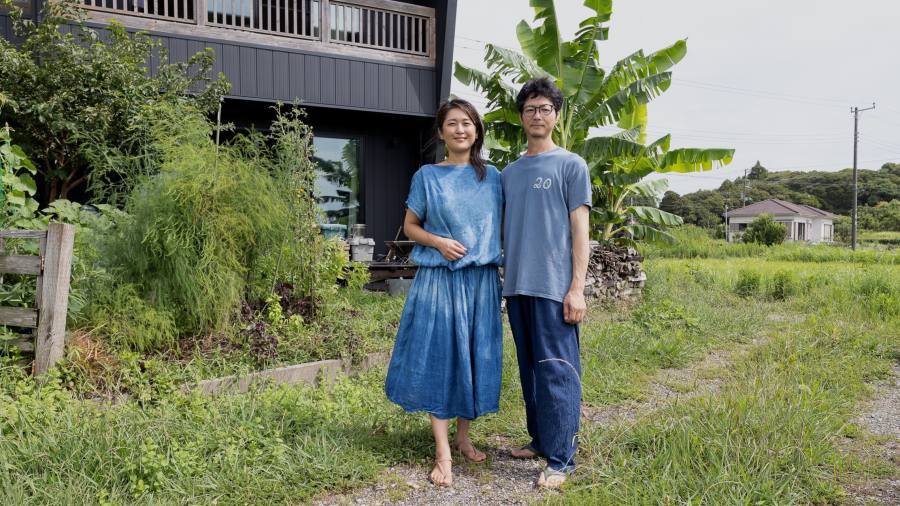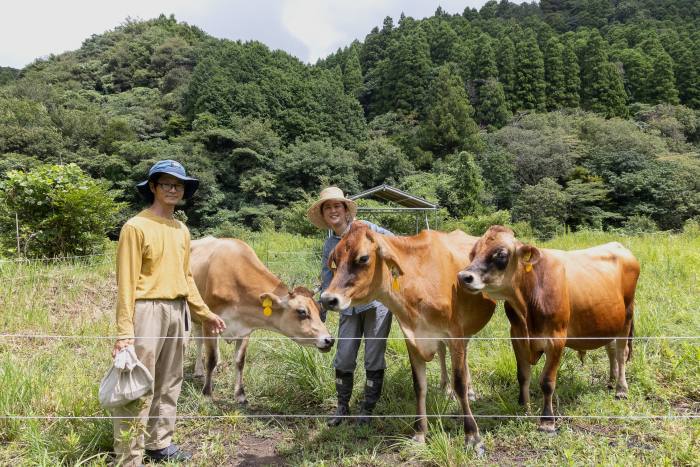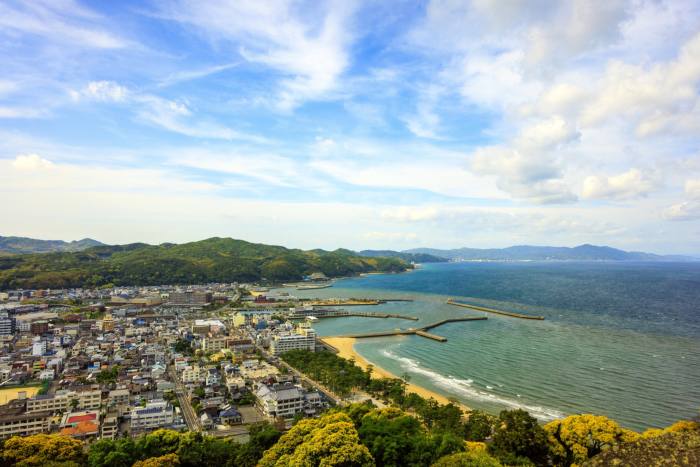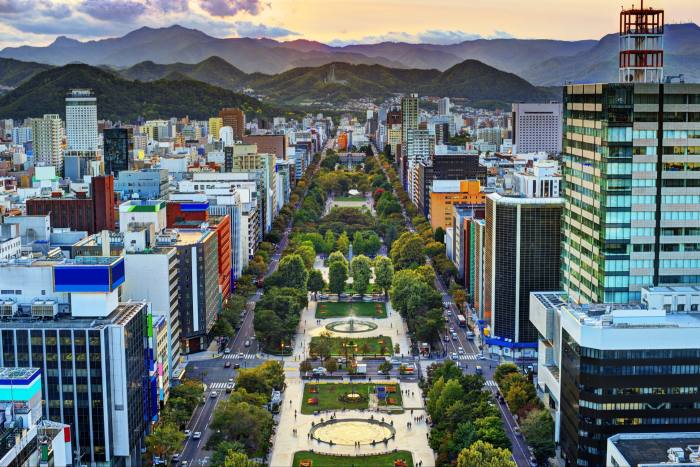
Go Komatsu and Hiromi Takahashi-Komatsu had been considering a move out of Tokyo before the pandemic. But, when Covid struck, the requirement for home schooling and the advent of homeworking made the move both more appealing and easier. So, in March 2021, the couple gave up their apartment and shared office in Tokyo, and rented a house near Isumi city, a rural part of Chiba Prefecture, about two hours’ drive from the capital, with their two children.
Today, they own three cows, which they keep on a rented smallholding, that will soon begin producing milk, from which they plan to make frozen yoghurt, selling it through the active local farmers’ network from whom they already buy much of their food.
“I enjoyed living, raising my children and working in Tokyo but, during the Covid-19 period, I was searching for ways to live with nature and living things, and improve the environment,” says Hiromi. “In Tokyo, you felt part of a marketplace where products were sold, but here you have a real sense of the land. It feels like a big difference.”
For years, Japan’s rural areas have struggled with depopulation, a function of an ageing population, declining birth rates and a preference for city life among young people. In April, a government incentive scheme designed to help address the problem increased the payment from ¥300,000 to ¥1mn ($6,860) per child for families leaving Tokyo’s 23 wards.
As Tokyo residents such as Go and Hiromi swap a life in Tokyo for one in the countryside, the historic trend of migration from rural areas and smaller cities to the capital is shifting.

In 2021, more people left Tokyo’s central 23 wards than arrived for the first time since records began in 2014, according to Japan’s Ministry of Internal Affairs and Communications. One year later, the net population inflow of 21,420 was still well below the 70,000 to 80,000 that was typical in the five years before the pandemic.
Company moves out of Tokyo have increased, too. Last year marked the second consecutive year where more companies left the city than arrived, according to business information company Teikoku Databank.
Before the pandemic, corporate moves used to favour locations near to Tokyo, such as Ibaraki and the other northern Kantō prefectures, according to a report on the trend published by Teikoku Databank in March. “However, as remote work has become established, remote areas as well as . . . cities with low population densities have become head offices,” the report notes.

Many of those leaving Tokyo are young families, says Kaz Harada, an estate agent at Tokyo company Hikari Home. “They move to enjoy nature, traditional Japanese culture and cheap rent.”
In 2019, Naoto Watanabe, now 35, and his wife were living in Tokyo’s Kōtō ward, looking for a two-bedroom flat to make room for their first child. They were already paying ¥130,000 ($890) a month to rent their 40 sq m one-bedroom apartment; for the extra bedroom, Watanabe reckoned he would have to pay another ¥50,000 a month.
So the couple moved to Awaji Island, where his employer also has an office, renting a 70 sq m three-bedroom home for ¥80,000 a month. Cheaper rent and living costs reduced the pressure on Watanabe’s wife to return to work following the birth of the couple’s two children, he says.

“This just wouldn’t have been possible in Tokyo — she would have had to rush back to work. It’s nice not to have to worry about finances.”
Watanabe says the move has not meant having to compromise on his own career ambitions. Part of the reason is the decision in September 2020 by his employer, Pasona, one of Japan’s largest employment companies, to shift many of its headquarters’ functions, and 1,200 staff, to Awaji Island, by May next year.
Go says the growing immigration from people leaving cities such as Tokyo is visible and exciting, with many new arrivals, like him and his wife, turning hobbies into an extra source of income. On our video call, Hiromi holds up two posters advertising farmers’ markets that she has helped organise since arriving. They are humorous cartoon images, one depicting a contented-looking cow trotting through a field of wild flowers, surrounded by a swarm of bees and butterflies.
“You see a lot of small businesses coming in, a lot of people starting new lives. More people are into DIY, renovating old homes or pursuing interests like honeybee farming,” says Go.
Lower prices have allowed those relocating from Tokyo to make a home purchase earlier than if they had stayed, or make one that they otherwise would not have made.
Daniel Chiang, a 40-year-old software engineer from Taiwan who moved to Tokyo in 2019, could have bought a home there but was uncomfortable with spending a large proportion of his savings on a home in a country he might leave.
In 2020, following the start of the pandemic, he and his wife (who have a two-year old daughter) made several short stays outside Tokyo to consider alternative locations, before moving to Sapporo, a city on the northern Japanese island of Hokkaido. There, they bought a two-bedroom flat in March 2022 for ¥28mn ($190,000) in the centre of the city — about a third of what the equivalent home would have cost where the family lived in Tokyo.
“Living feels much less crowded than in Tokyo and in Sapporo the different seasons are more pronounced,” says Chiang, who relocated to London last November to take up a job at Meta.
Back in Tokyo, the family rarely left the city at weekends; from Sapporo they drove to the mountains or a nearby forest on most Saturday mornings. During the winter, Chiang skied frequently at a local resort, about 30 minutes away by car.

“In Tokyo you wouldn’t bother to travel to the country: it just takes too long and the journey is congested and unpleasant. Leaving Sapporo, you drive through beautiful [countryside] almost immediately. I liked taking my daughter to places where she could explore nature,” he says.
The family plan to return to the home for two months over the winter, with Chiang working remotely, to coincide with the ski season. Unlike a flat in Tokyo, it is one they will use long into the future, he says. “It’s a great place to visit for vacations and we feel we want to retire to it one day,” he says.
Despite the benefits, a move out of Tokyo also comes with challenges. Chiang and his wife made up for the lack of a local work social circle by meeting new friends on Facebook groups for Taiwanese expats and over Line, a popular messaging app in Taiwan. But many were located outside Sapporo, meaning travelling to meet them took longer. “In Tokyo, people are nearer so it’s easier to meet for dinner. From Hokkaido you might need to drive for an hour to meet someone,” he says.
Watanabe misses the restaurants and shops of Tokyo and their later opening hours. “And we like visiting museums — the city had so many of these; on Awaji Island there are fewer and they are smaller,” he says.
“While living outside the city provides a fulfilling life, it becomes very car-centric,” observes Hiromi. By expanding the farmers’ market initiative, she hopes to help the long-term goal of more “walkable towns”, allowing locals to shop and interact without having to get in their car, fostering community and improving health with exercise.
There is no shortage of new arrivals interested to participate, she says. “There are four locations that are making cheese, 10 honey farms, and several people who moved from Tokyo have started bakeries.”
Find out about our latest stories first — follow @FTProperty on X or @ft_houseandhome on Instagram